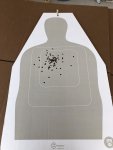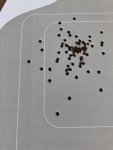When I was at the academy, we did a pistol qual that I thought did not do a good job of testing handgun skills. The qual was such:
4yd line 2 rounds from holster 8 seconds x2
4yd line 2 rounds weapon hand only starting from close ready 8 seconds
4yd line 2 rounds reaction hand only from close ready 8 seconds
7yd line 2 to the body, 2 to the head from the holster 10 seconds x2
7yd line 2 rounds weapon hand only
7yd line 2 rounds reaction hand only
15yd line 6 rounds from the holster 15 sec x2
25yd line 6 rounds in 25 seconds
30 rounds for a total score of 300. 220 minimum to pass. Target is full size silhouette. Large ring is 10pts, 7, 3, and 0 for no hits on the scored portion but does not count against you. Just a zero.
Without naming your department, what does your agency do for a pistol qual?
4yd line 2 rounds from holster 8 seconds x2
4yd line 2 rounds weapon hand only starting from close ready 8 seconds
4yd line 2 rounds reaction hand only from close ready 8 seconds
7yd line 2 to the body, 2 to the head from the holster 10 seconds x2
7yd line 2 rounds weapon hand only
7yd line 2 rounds reaction hand only
15yd line 6 rounds from the holster 15 sec x2
25yd line 6 rounds in 25 seconds
30 rounds for a total score of 300. 220 minimum to pass. Target is full size silhouette. Large ring is 10pts, 7, 3, and 0 for no hits on the scored portion but does not count against you. Just a zero.
Without naming your department, what does your agency do for a pistol qual?




